Jewish Historical Fiction for Older Readers: The Holocaust (Page 2) |
If you wish to purchase any of these books, click on either the title or the book cover to be directed to Amazon.com. As a warning, I have put up pictures of the book covers to give you somewhat an idea of the style of each book (I know, I know. "Don't judge a book by its cover") so the pages may load slowly, depending on the speed of your internet connection.
If this page came up without frames, Click here to see the complete website
NOTE: For biographies of individuals associated with the Holocaust (Anne Frank,
Simon Wiesenthal, etc.), go to the
Biographies
For Nonfiction Holocaust books, go to the
Holocaust History Page
For Holocaust books for younger readers, go to the Children's History Page
Other Pages of Interest:
Holocaust Historical Fiction Books For Middle School and Young Adult Readers ...
(Page 1)
(Page 2)
(Page 3)
(Page 4)
(Page 5)
(Page 6)
Holocaust History Books For Middle School and Young Adult Readers (Nonfiction)...
(Page 1)
(Page 2)
(Page 3)
(Page 4)
(Page 5)
(Page 6)
Middle School and YA Books ...
Bar Mitzvah Books |
Jewish Fiction |
Historical Fiction |
Torah Study |
Prayer and Jewish Life Books |
Jewish Holidays |
Jewish Biographies |
Jewish History Books |
Holocaust Books for Teens |
Israel Books
Jewish Historical Fiction for Middle School and YA Readers...
Biblical Era |
Middle Ages, Renaissance, and the Spanish Inquisition |
Immigration & The American Experience |
European History |
Holocaust
(Page 1)
(Page 2)
(Page 3)
(Page 4)
(Page 5)
(Page 6) |
Israel
Jewish History Books for Middle School and Young Adult Readers ...
General Jewish History & Nonfiction |
Biblical Era |
European History (Excluding the Holocaust) |
Immigration & The American Experience |
Holocaust |
Israel
Easy Reader and Picture Books ...
Jewish Children's Books (General) |
Jewish Board Books |
Biblical Stories for Children |
Jewish Holiday Books |
Jewish Family Cookbooks |
Folktales and Talmudic Stories for Children |
Jewish Life Books (Mitzvot, Keeping Kosher, etc.) |
Jewish Life Cycle Books |
Family Haggadahs |
Children's Prayerbooks |
Introductory Hebrew Books |
Jewish History and Historical Fiction Picture Books |
Israel Books
And More ...
Jewish Books for Children |
Bar Mitzvah Books |
Jewish Parenting Books |
Hanukkah Books |
Jewish Music for Children |
Jewish Videos |
Jewish Toys and Gifts |
Jewish Gift Baskets and Gourmet Food |
Jewish Jewelry |
Amazon.com Coupons, Promotions, and Sales
NOTE: For biographies of individuals associated with the Holocaust (Anne Frank,
Simon Wiesenthal, etc.), go to the
Biographies
For Nonfiction Holocaust books, go to the
Holocaust History Page
For Holocaust books for younger readers, go to the Children's History Page
Other Pages of Interest:
Holocaust Historical Fiction Books For Middle School and Young Adult Readers ...
(Page 1)
(Page 2)
(Page 3)
(Page 4)
(Page 5)
(Page 6)
Holocaust History Books For Middle School and Young Adult Readers (Nonfiction)...
(Page 1)
(Page 2)
(Page 3)
(Page 4)
(Page 5)
(Page 6)
Middle School and YA Books ...
Bar Mitzvah Books |
Jewish Fiction |
Historical Fiction |
Torah Study |
Prayer and Jewish Life Books |
Jewish Holidays |
Jewish Biographies |
Jewish History Books |
Holocaust Books for Teens |
Israel Books
Jewish Historical Fiction for Middle School and YA Readers...
Biblical Era |
Middle Ages, Renaissance, and the Spanish Inquisition |
Immigration & The American Experience |
European History |
Holocaust
(Page 1)
(Page 2)
(Page 3)
(Page 4)
(Page 5)
(Page 6) |
Israel
Jewish History Books for Middle School and Young Adult Readers ...
General Jewish History & Nonfiction |
Biblical Era |
European History (Excluding the Holocaust) |
Immigration & The American Experience |
Holocaust |
Israel
Easy Reader and Picture Books ...
Jewish Children's Books (General) |
Jewish Board Books |
Biblical Stories for Children |
Jewish Holiday Books |
Jewish Family Cookbooks |
Folktales and Talmudic Stories for Children |
Jewish Life Books (Mitzvot, Keeping Kosher, etc.) |
Jewish Life Cycle Books |
Family Haggadahs |
Children's Prayerbooks |
Introductory Hebrew Books |
Jewish History and Historical Fiction Picture Books |
Israel Books
And More ...
Jewish Books for Children |
Bar Mitzvah Books |
Jewish Parenting Books |
Hanukkah Books |
Jewish Music for Children |
Jewish Videos |
Jewish Toys and Gifts |
Jewish Gift Baskets and Gourmet Food |
Jewish Jewelry |
Amazon.com Coupons, Promotions, and Sales
Other Pages of Interest:
Holocaust Historical Fiction Books For Middle School and Young Adult Readers ...
(Page 1)
(Page 2)
(Page 3)
(Page 4)
(Page 5)
(Page 6)
Holocaust History Books For Middle School and Young Adult Readers (Nonfiction)...
(Page 1)
(Page 2)
(Page 3)
(Page 4)
(Page 5)
(Page 6)
Middle School and YA Books ...
Bar Mitzvah Books |
Jewish Fiction |
Historical Fiction |
Torah Study |
Prayer and Jewish Life Books |
Jewish Holidays |
Jewish Biographies |
Jewish History Books |
Holocaust Books for Teens |
Israel Books
Jewish Historical Fiction for Middle School and YA Readers...
Biblical Era |
Middle Ages, Renaissance, and the Spanish Inquisition |
Immigration & The American Experience |
European History |
Holocaust
(Page 1)
(Page 2)
(Page 3)
(Page 4)
(Page 5)
(Page 6) |
Israel
Jewish History Books for Middle School and Young Adult Readers ...
General Jewish History & Nonfiction |
Biblical Era |
European History (Excluding the Holocaust) |
Immigration & The American Experience |
Holocaust |
Israel
Easy Reader and Picture Books ...
Jewish Children's Books (General) |
Jewish Board Books |
Biblical Stories for Children |
Jewish Holiday Books |
Jewish Family Cookbooks |
Folktales and Talmudic Stories for Children |
Jewish Life Books (Mitzvot, Keeping Kosher, etc.) |
Jewish Life Cycle Books |
Family Haggadahs |
Children's Prayerbooks |
Introductory Hebrew Books |
Jewish History and Historical Fiction Picture Books |
Israel Books
And More ...
Jewish Books for Children |
Bar Mitzvah Books |
Jewish Parenting Books |
Hanukkah Books |
Jewish Music for Children |
Jewish Videos |
Jewish Toys and Gifts |
Jewish Gift Baskets and Gourmet Food |
Jewish Jewelry |
Amazon.com Coupons, Promotions, and Sales
Holocaust History Books For Middle School and Young Adult Readers (Nonfiction)... (Page 1) (Page 2) (Page 3) (Page 4) (Page 5) (Page 6)
Middle School and YA Books ... Bar Mitzvah Books | Jewish Fiction | Historical Fiction | Torah Study | Prayer and Jewish Life Books | Jewish Holidays | Jewish Biographies | Jewish History Books | Holocaust Books for Teens | Israel Books
Jewish Historical Fiction for Middle School and YA Readers... Biblical Era | Middle Ages, Renaissance, and the Spanish Inquisition | Immigration & The American Experience | European History | Holocaust (Page 1) (Page 2) (Page 3) (Page 4) (Page 5) (Page 6) | Israel
Jewish History Books for Middle School and Young Adult Readers ... General Jewish History & Nonfiction | Biblical Era | European History (Excluding the Holocaust) | Immigration & The American Experience | Holocaust | Israel
Easy Reader and Picture Books ... Jewish Children's Books (General) | Jewish Board Books | Biblical Stories for Children | Jewish Holiday Books | Jewish Family Cookbooks | Folktales and Talmudic Stories for Children | Jewish Life Books (Mitzvot, Keeping Kosher, etc.) | Jewish Life Cycle Books | Family Haggadahs | Children's Prayerbooks | Introductory Hebrew Books | Jewish History and Historical Fiction Picture Books | Israel Books
And More ... Jewish Books for Children | Bar Mitzvah Books | Jewish Parenting Books | Hanukkah Books | Jewish Music for Children | Jewish Videos | Jewish Toys and Gifts | Jewish Gift Baskets and Gourmet Food | Jewish Jewelry | Amazon.com Coupons, Promotions, and Sales
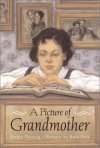 A Picture of Grandmother By Esther Hautzig |
A moving story of a secret that tears a family apart and the love that brings it together.
When Sara sees the large blue-and-white envelope that came in the mail, she knows it's from her uncle Benjamin in America. Usually he sends wonderful photographs of his life in Brooklyn, but this time Benjamin has invited Mama and Grandmother Hanna to the 1939 World's Fair in New York, and instead of sending pictures, he's requested an old photo of his mother -- a picture that Sara has never seen and a request that upsets her mother. Assuming that the photo has been lost, Sara takes it upon herself to find it. But no one in the family will talk to her about it. That's why Sara goes to visit her outspoken aunt Lisa, knowing she will have some answers for her. But the answer Sara gets is one she never expected to hear. Esther Hautzig's clear, evocative telling and Beth Peck's lovely renderings from old photographs create a vivid portrait of a family on the eve of World War II. |
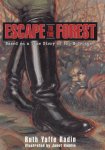 Escape to the Forest : Based on a True Story of the Holocaust by Ruth Yaffe Radin |
When the Nazis invade Poland, nothing is safe anymore.
Ten-year-old Sarah and her family must leave their home and live in a
Jewish ghetto surrounded by barbed wire. There, life is a nightmare of
cold and hunger where Nazi soldiers kill Jews at will. But Sarah still hears
stories that give her hope—stories about a man who lives in the nearby
forest, fighting the Nazis and sheltering the Jews.
Sarah's brother thinks they should try to escape to the forest. Her parents
think they will be safer where they are. Sarah doesn't know who is right.
But as life in the ghetto grows worse and worse, the forest may be their
only hope. Based on a true story of life during the Holocaust, this is a
heartrending novel of one family's struggle to survive.
From Radin (All Joseph Wanted), a short, accessible novel that could serve as a introduction to the realities of the Holocaust. Sarah, a young Jewish girl, lives in eastern Poland, where the Russians have taken control of her town and imposed harsh restrictions. The family must celebrate Hanukkah in secret; Lili, a girl from western Poland whom the family shelters, is arrested. Eventually Lili is released, but when the Germans attack they force the family into a small ghetto. Jews are being murdered in the streets, and Sarah's brother, David, knows that a family, the Bielskis, have escaped into the forest. Sarah's mother, believing that life in the forest would be worse, refuses to leave the ghetto even after the family survives a selection by the Germans. When ordered onto a train that will take them to Treblinka, her father tells Sarah to leave; she must find the Bielskis in the forest in order to survive. The fact that this is a true story lends the narrative further immediacy and suspense. Compelling reading for the young. |
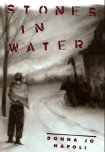 Stones in Water By Donna Jo Napoli |
Awards:
The day Roberto and his friend Samuele are rounded up by German soldiers and put on a train marks both a beginning and an end. The boys have now become part of the war, providing forced labor for the Nazis at various work camps deep inside German territory. And it's the ending to all they've known -- before their lives as children in Venice, their innocence. For Roberto, the present is unbearable -- backbreaking work, near starvation, and protecting Samuele's secret that, if discovered, would mean death for both boys. Escape is Roberto's only hope, but the Russian winter is upon the land -- and any hope seems remote. But compared to the horrors he has suffered, can freezing be worse? Using the shimmering language that has marked her books Zel and The Magic Circle, Donna Jo Napoli writes a wrenching novel of a boy caught up in a war he hates. As pure as the snow that covers the vast lands he must cross, and as hard as the gift stone he carries with him as a kind of talisman, this is both a war story and a survival story. It is not only the story of how Roberto lives to tell his tale of cruelty and terror, but also how dreams and hope can endure despite the harshest tests. This gripping, meticulously researched story (loosely based on the life of an actual survivor), set in Europe during WWII, is told from the point of view of a Venetian boy forced into war against his will. Roberto's quiet life as a gondolier's son ends abruptly the day he sneaks off to see a movie with his older brother and two friends, Memo and Samuele. German soldiers raid the theater and take the boys captive, and Roberto is immediately separated from his brother. Roberto and his two friends are carted by train across the border and quickly learn that although the Germans are allies, they consider the Italians dispensable (Nazi soldiers shoot three Italian boys on a train platform). Roberto is concerned for his own safety, but he is even more fearful for his Jewish friend Samuele (Roberto and Memo flank him when Samuele urinates, to hide his circumcision). When the train finally halts, Roberto and Samuele manage to stay together, while Memo is sent to a different camp. In the first half of the novel, Roberto describes the abominations he and Samuele both endure and witness as they are sent from one work camp to the next. At one, the boys build a large pen that the Germans later fill with Jews; horrified, Roberto puts himself at great risk to smuggle food daily through the barbed wire to a starving girl and her sister. The second half recounts Roberto's lone escape across Ukraine's barren landscape after Samuele dies fighting for a pair of German boots. Napoli's graphic depiction of the boys' inhumane treatment counterpoints their quiet nurturing of each other's spirits. Roberto gives half his food rations to Samuele (because a boy who knows Samuele's secret is confiscating his food), and Samuele helps Roberto fall asleep by telling him comforting stories from the Old Testament. Napoli portrays a war in which resisters and deserters are the real heroes. In her choice of an innocent boy as first-person narrator, she gently leads readers through a gradual unfolding of events until they come face-to-face with the scope of the war's atrocities. Children will be riveted by Roberto's struggle to stay aliveand to aid others along the wayagainst enormous odds. And adults may never view WWII the same way again. From Napoli (Trouble on the Tracks), a powerful novel set in a vividly realized wartime milieu. Roberto, a Venetian boy who is about to graduate from middle school, is so eager to attend a rare American movie that he makes a worrisome bargain with a boy who is always in trouble. On top of this small sin, he attends the movie with a Jewish boy, Samuele, an unwise idea when restrictions and dangers are multiplying. German soldiers enter the theater and capture all the boys; at first, Roberto can't make sense of what is happening to him. Transported to desolate regions, the boys are forced into labor building a tarmac; food is scarce, the climate is life-threatening, and survival seems remote. Now called Enzo, Samuele, who has a deeper understanding of the situation and who constantly watches for a chance to defy his captors, tells Roberto stories that become crucial to his sanity and lend a semblance of humanity to their desperate situation. When Roberto escapes, the book becomes a memorable survival story: He learns not to speak and give away his nationality, puzzles out the changing borders and alliances of the war, eats slugs in snow-covered streams to survive, and battles wild animals. Finally, by participating in the partigiano, who sabotage the war and work to hide endangered Jews, Roberto goes from victim to hero, seizing control of his life for a noble cause. Riveting. |
 Prisoner in Time : A Child of the Holocaust By Pamela Melnikoff |
Twelve-year old Jan lives with his loving family in one of the most
beautiful cities in Europe. But his life has begun to change, for it
is 1942 and the Nazis have marched into Prague-and Jan is Jewish.
When the Nazis take his family away to the concentration camp at Terezin, Jan finds shelter with friends. But a year's confinement in their attic becomes too much for him to bear and he recklessly ventures into the dangerous streets of the city. Now Jan's only refuge is the ancient Jewish cemetery and the tomb of Rabbi Loew, who created a legendary giant - the Golem - to save his people from oppression hundreds of years earlier. Miraculously, Jan travels back in time to the momentous events of the sixteenth-century Prague. Perhaps he, in turn, will find a way to escape from the fate that would befall a million and a half Jewish children in Nazi-occupied Europe. While Jan, 12, is hiding from the Nazis in Czechoslovakia in 1942, he finds an amulet that takes him back to sixteenth-century Prague, where he helps the famous Rabbi Loewe create the legendary monster Golem to scare the racists who accuse the Jews of murdering Christian children. When Jan returns to his own time, he's transported to Terezin concentration camp. The historical parallels are important (anti-Semitism didn't begin with the Nazis, and many readers will want to pursue the Golem legend), but most of this honest docunovel is about what it was like to be a teenager in Terezin. Through Jan's eyes, Melnikoff presents the daily horror and brutality, and she includes some famous people (among them, Friedl Dicker-Brandejsova, who ran secret art classes for children) and true events, like the Nazis' prettying up of Terezin for Red Cross inspection. Unlike Jane Yolen's Devil's Arithmetic, there's no slick upbeat ending to the time travel. Like nearly every one of the 15,000 children at Terezin, Jan is sent to a death camp. |
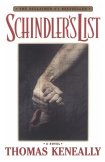 Schindler's List By Thomas Keneally |
Awards:
Schindler's List is a remarkable work of fiction based on the true story of German industrialist and war profiteer, Oskar Schindler, who, confronted with the horror of the extermination camps, gambled his life and fortune to rescue 1,300 Jews from the gas chambers. Working with the actual testimony of Schindler's Jews, Thomas Keneally artfully depicts the courage and shrewdness of an unlikely savior, a man who is a flawed mixture of hedonism and decency and who, in the presence of unutterable evil, transcends the limits of his own humanity. |
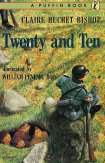 Twenty and Ten By Claire Huchet Bishop |
During the German occupation of France, twenty French children were brought to a
refuge in the mountains. One day a young man came to their school with a request:
Could they take in, and hide, ten Jewish refugee children?
Sister Gabriel spoke up. "The Nazis are looking for those children. If we take them we must never let on that they are here. Do you understand?" Of course the children understood - but how would they hide them if the Nazis came? I read Twenty and Ten when I was a 3rd grader (about 30 years ago), and is my lifetime favorite book. The story, based on an actual situation, describes how 20 Christian children used their wits and compassion to hide 10 Jewish children from the Nazis during World War II. The children's experiences are truly an adventure, yet do not trivialize the Holocaust. Although I do not recommend teaching young children about the Holocaust's grim details, this book opens the discussion about people's responsibility to one another regardless of differences. I have yet to find a child or adult who can put the book down once they start reading it |
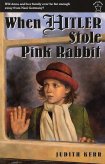 When Hitler Stole Pink Rabbit By Judith Kerr |
Anna was only nine years old in 1933, too busy with her school work and
friends to take much notice of Adolf Hitler's face glaring out of political
posters all over Berlin. Being Jewish, she thought, was just something you
were because your parents and grandparents were Jewish. But then one
day her father was unaccountably, frighteningly missing. Soon after, she and
her brother, Max, were hurried out of Germany by their mother with
alarming secrecy. Reunited in Switzerland, Anna and her family embark
on an adventure that would go on for years, in several different countries.
They learn many new things: new languages, how to cope with the wildest
confusions, and how to be poor. Anna soon discovers that there are special
skills to being a refugee. And as long as the family stayed together, that was
all that really mattered.
We follow Anna, her brother, and her father as they travel through Europe, living as refugees, staying a few steps ahead of the Nazis. Although When Hitler Stole Pink Rabbit avoids most of the details of the actual Holocaust, it provides young readers with a gentle, yet important, introduction to a horrible chapter in world history. |
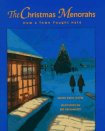 The Christmas Menorahs : How a Town Fought Hate By Janice Cohn |
Based on a true incident that occurred in Billings, Montana, this story
begins when a rock is thrown through a boy's bedroom window in
which a menorah is displayed. The boy, Isaac, is frightened and unsure
whether he wants to put the menorah back. His parents call the police,
and his mother goes on television and to a meeting to talk about hate
crimes in the community. Inspired by stories of the Danish people
helping their Jewish neighbors during World War II, the people of
Billings put menorahs in their windows to take a stand against bigotry.
When a schoolmate supports Isaac, he takes his own stand by returning
the menorah to its place. Cohn deals with the issues in a way children
can readily understand.
Throughout the book, realistic, soft-focus oil paintings dramatize the
action and personalize the characters. A fine book for parents and
teachers who want to discuss prejudice and hate crimes with their
children, with background information provided in the introduction.
|
 Escape from the Holocaust (Do-It-Yourself Jewish Adventure Series) By Kenneth Roseman |
As a young Jewish medical student in Berlin in the 1930's, the reader in
confronted with choices that could mean the difference between freedom and
slavery, life and death. Should you stay in Germany or return to Poland?
Will you try to reach Eretz Yisrael?
|
 Behind the Bedroom Wall By Laura E. Williams |
Awards:
In World War II Germany, Korinna is thirteen years old and an ardent member of the Jungmdel, a Hitler youth group. Her belief that "Hitler is the most wonderful man" is reinforced by her school books, the youth group leaders, her friends, and the society around her. To be a "Jew-lover" is the worst accusation that can be made about a non-Jew. Witnessing a brutal arrest being made by a Gestapo officer who is the brother of her best friend Rita, Korinna suppresses any feelings of sympathy for the victim. When she discovers that her parents are hiding a Jewish woman and her five-year-old daughter Rachel in a small space behind the wardrobe in her bedroom, her world is shattered. Her first reaction is that she must report her parents as traitors even though she has been told that traitors are shot. Living with her secret, Korinna finds that pity for little Rachel begins to turn into affection. As the tension increases between her sense of duty to the Fuhrer and love for her parents, she begins to make mistakes, even allowing the overly zealous Rita to trap her into confiding that she sometimes feels sorry for Jews. The very next day, Korinna is ostracized at school, and one of her old friends whispers that her house will be raided that night. The Jewish family is safely sent on to the next hiding place; and when the Gestapo officers tear through the house and find the space behind the bedroom wall, Korinna has already transformed it into a little shrine to Hitler. With the brief reprieve that this ruse brings them, Korinna and her parents are able to escape. Somewhat superficial but easy to read and immediate in its assumption of Korinna's perspective, the novel gives fearful insight into the ways young minds can be molded to hate. It also offers a glimmer of hope that, in the darkest of times, there are some brave people who will risk their own lives to help others. |
 Waiting for Anya By Michael Morpurgo |
Like the acclaimed Number
the Stars, this well-plotted novel features a young Gentile hero
battling the Germans in their war against the Jews. As it opens, Jo is
guarding the sheep when his dog alerts him to a bear; Jo warns the
villagers in his small French town and they kill the hapless beast. The
theme here prefigures the more tragic hunt for human prey, while the
bear chase itself brings Jo into contact with Benjamin, the reclusive
Widow Horcada's Jewish son-in-law, who is hiding in her mountain
home. Separated from Anya, his daughter, Benjamin hides other
Jewish children and leads them to safety in nearby Spain. Jo is soon
enlisted, bringing supplies to the widow's house. Then the Germans
encamp in Jo's village, observing everyone and sealing the Spanish
border. Jo's concern for the Jews is measured against his reluctant
awareness that the German occupiers are not uniformly evil--in fact,
the villagers' relations with the Germans form the most distinctive
element of the story. Although some key elements are historically
improbable (chiefly, a German officer's partial rejection of Nazi
principles), the adventure of the Jews' escape into Spain is both
gripping and temperate.
An action-packed historical novel that takes place during World War II in Vichy, France. Young shepherd Jo discovers that Widow Horcada's son-in-law is hiding Jewish children at her farm and smuggling them over the border into Spain. A gripping, clearly written story, giving readers much to ponder. |
 A Pocket Full of Seeds By Marilyn Sachs |
Awards:
Nicole's parents, Jews in unoccupied France, decide to take a chance and wait out the war. Then one awful day Nicole comes home from school to find her entire family gone. The Nazis who have taken them are still looking for her. Where can she hide? "A significant addition to the collection of children's books dealing with World War II."--The Boston Globe. |
 In My Enemy's House By Carol Matas |
A gripping novel about the Holocaust, this is the story of
Marisa, a teen whose life changes dramatically when her
small Polish village is invaded by the Nazis and most of
her family is taken away. Because Marisa is blond and
blue eyed, she is able to hide her Jewish identity. After
several grueling experiences and with the help of some
fake documentation and language lessons, she is sent to
Germany and becomes a servant to Herr Reymann, a
high-ranking Nazi official. Marisa finds comfort and
affection in the family but is constantly aware of their
virulent anti-Semitism, ignorance, and prejudice. Marisa
knows she must keep her true identity secret at all costs
and struggles to retain a sense of identity, her faith, and
even her will to live. The novel allows readers to view the
war from multiple perspectives and adds many valuable
layers of insight. Although this is fiction, it has the immediacy
and impact of a true story. Marisa's ordeal is compelling,
moving-and deeply disturbing. Readers will end up
pondering the same complexities of human nature and
history that the protagonist does.
|
 To Cross a Line By Karen Ray |
During the final weeks of 1938, Kristallnacht echoes in the recent memory
of 17-year-old Egon Katz, a Jewish baker's apprentice. Delivering pastries
one rainy afternoon, Egon crashes his rickety scooter into a high-ranking
Nazi's car. Sentenced initially to pay a fine of 80 marks, Egon soon learns
that the Gestapo are pursuing him. He packs a few belongings and turns to
his extended family for help. In a story that becomes ever more suspenseful,
Egon encounters barriers in his increasingly desperate efforts to leave
Germany. His refined appearance denies him exit into Holland with a group
of Jewish men disguised as coal miners. However, through his brother's help,
Egon makes his way to the Danish border, where, again, he narrowly escapes
the Gestapo.
Ray uses Egon's memories as a device to tell a second story, that of Egon's family and his past. Skillfully layered through this thrilling, sparely written story of a teenager's struggle for survival are details of Jewish life and culture, as conducted in the face of Nazi persecution. As an account of an individual boy's experiences during the Holocaust's beginnings, the book effectively personalizes that time and place for young adult readers. In an afterword, Ray explains that her book fictionalizes her father-in-law's scooter accident and his subsequent escape from Hitler's Germany. As this dramatic historical novel opens, 17-year-old Egon Katz is smiling to himself as he delivers bread and Christmas cookies to the neighbors. But something is wrong with this picture of holiday cheer: it is Germany in 1938 and Egon is a Jew. Kristallnacht has just occurred; Egon has already been humiliated in school and denied basic rights, and his sister's mysterious disappearance is met by indifference by the police. He knows not to attract the attention of the Gestapo, but disastrously, he does exactly that when he gets into a traffic accident which is the fault of a prominent Nazi Party member. Egon then becomes a fugitive. After wending a tortuous route, he arrives at the Danish border on Christmas Day and eventually gains freedom through the good will of a Danish sergeant. This true story about the author's father-in-law is not unrealistically upbeat, however, and Ray describes the particular fates of members of Egon's family in an afterword. Told in straightforward prose, the story is absorbing, hopeful yet not naive. To Cross a Line, Karen Ray's first novel for children, is about one young man's narrow escapes. It gets off to a slow, awkward start in the first few pages, but once the action starts, Ms. Ray proves to be a wonderful storyteller. . . . There are moments--as when Egon writes a farewell letter to his mother--that are both beautiful and heartbreaking. Ms. Ray deftly works in historical facts. . . . But 'To Cross a Line' is not explicitly didactic, it's a persuasive novel. . . . It may come as a surprise to some young readers to discover, in the author's afterword, that Egon's adventures are based on real-life experience. |
 The Broken Mirror : A Novella by Kirk Douglas |
A timeless tale of loss and faith recovered by actor/author Kirk Douglas. After World War II ends a Jewish boy whose family has been killed by the Nazis lies to his American liberators, telling them that he is a Gypsy rather than a Jew. Sent to a Catholic orphanage, Moishe runs away after his best friend there is adopted. When all seems utterly hopeless, Moishe finds solace in the light of the Sabbath candles and in his abandoned Judaism. |
 The Final Journey By Gudrun Pausewang |
What was it like in the railway cattle cars bound for Auschwitz? This
novel, first published in Germany in 1992, tells it from the viewpoint
of an 11-year-old Jewish girl. Alice Dubsky has spent two years in
hiding in a basement, protected from the knowledge of the Nazi
persecution of the Jews. Now suddenly, crammed with nearly 50 people
in the hot, stinking darkness of the train car, she faces the fact
that they are prisoners being taken to a camp. That must be why her
parents disappeared months before. She sees her grandfather die and
witnesses the miracle of a baby born in the excrement, even as she
learns for the first time from a young woman how babies are made.
People cling to their possessions. Some share and help one another.
Someone else dies. The train stops at sidings; people outside hear
the cries and do nothing.
Do we need another book about the Holocaust? Yes, if it is as good as this one. This is not a book for children, but teens and adults will find it compelling reading, an extension of the autobiographical journeys of Primo Levi's Survival in Auschwitz and Isabella Leitner's The Big Lie. Crampton's translation is restrained; the dialogue rings true; the details are authentic. There is no exploitation; in fact, there is almost no direct violence. The end is quiet and devastating. They get there. The Auschwitz commander sends some to the right; Alice goes to the left, together with the other children, the old, the disabled, and the newborn baby. They strip for the "showers." Alice Dubsky's final journey begins in the cattle car of a train and ends in the "shower rooms" of Auschwitz. But her journey is also one of self-discovery as she learns the truths about the Holocaust. On the train twelve-year-old Alice relives memories from her childhood and years in hiding in the basement apartment of her former family home. Kept in the dark, both literally and figuratively, by her parents and grandparents, Alice doesn't know about what is happening to the Jews in Germany. But she slowly awakens to the harsh realities hidden from her through the indignities and inhumanity of the cattle car and the knowledge gained from her fellow deportees. This is a descriptive, moving, and frightening story. The reader learns of Alice's losses, of her home, her freedom, her parents, her grandparents, and finally her innocence and her life. But the most powerful impact is felt through Alice's reactions to all that is happening around her. This novel could be used in conjunction with the recent Fragments by Binjamin Wilkomirski. Its detail gives body to many of the impressions found in Fragments. It would also be good companion reading to The Diary of Anne Frank. All that eleven-year-old Alice had known was happiness with her parents and grandparents. Then, two years ago, they moved into the basement of their house, and Alice has not been outside since. Now her parents have disappeared, and Alice and her grandparents are roused in the middle of the night and herded to the rail station. Separated from her grandmother, Alice and her grandfather are crammed into a rail car headed for an unknown destination. As the trip progresses, Alice begins to understand what it means to be a Jew in Hitler's Germany. Pausewang is both touching and brutally honest about the horrors that Jews underwent during Hitler's reign. Readers learn of the unfounded hatred directed toward the Jews, their inhumane treatment, and the maturity that comes quickly with tragedy. However, Pausewang also shows that love and an optimistic spirit can prevail in spite of horrendous circumstances. |
 Missing Girls By Lois Metzger |
Thoughtful readers and their parents will find this multilayered story of mother-daughter tensions hauntingly real, and a great discussion book. Ever since her beautiful red-haired mother died of cancer four years ago, Carrie, 13, has been a "missing girl," veritably sleepwalking through each day. And she has a recurring dream: her mother sits at the kitchen table, alive but unsmiling and remote. When her new friend Mona offers to teach her about lucid dreaming--"being awake while being asleep"--she is powerfully attracted to the idea. Could she possibly talk to her mother in her dreams?
But Carrie can't bear to face her confused feelings about her mother's death, especially with her friends, who are loud about their dislike of their own mothers. So where can she find a dream she is willing to share? She has always resisted hearing her grandmother's stories of the Holocaust, but now she begins to listen avidly, and passes off as her own the images of rats and terror from her grandmother's recollections, which she describes to Mona. As Carrie hears these horror stories with fresh ears, her contempt for her immigrant grandmother turns to compassion, and she comes to a fuller understanding of her mother's childhood. When Carrie at last has a lucid dream, the dream figure turns away with an apologetic smile from her daughter's attempts to communicate, making it possible for Carrie to accept that her mother no longer exists--and to wake up to her own life. Carrie is fascinated by the idea of missing girls, girls who disappear and never return. She isn't missing, but she feels alienated and alone, as if she were missing from her own life. Because her mother is dead and her father is away for a year, the eighth grader has had to leave her home and friends to live with her immigrant grandmother. As Carrie attempts to find herself, she and her new friend Mona explore "lucid dreaming," the state of being awake or aware within a dream and controlling it. Carrie listens to her grandmother's stories of being an Austrian Jew during the Nazi occupation, and of sending Carrie's mother to Scotland for safety during the war. The girl tries to use these stories and her dreams to reconnect with her dead mother. She attaches herself to and is hurtfully rejected by Mona's mother, a self-centered psychologist. Finally forced to reconnect with her own family, she discovers that she is not "missing" anymore. Metzger uses the 1967 setting and the Vietnam War to focus on Carrie's grandmother's and mother's wartime ordeals a generation earlier, but the setting itself is not crucial to the story. The sympathetic development of the teenage characters contrasts markedly to the uncaring, cold roles of Mona's parents and the inability of Carrie's father and grandmother to reach through Carrie's sense of isolation. Like Metzger's Barry's Sister and Ellen's Case, this novel is intense and complex, and it is as satisfying as finding a misplaced treasure.- |
 Greater Than Angels By Carol Matas |
Set in Vichy, France, this novel covers a section of Europe often overlooked in Holocaust
literature. Anna, 13, along with her mother, her aunt, and grandmother, are deported from
Germany to Gurs, a refugee camp on the French-Spanish border. The details of the journey
and the terrible conditions there are vividly and realistically described. Anna's grandmother
dies and the girl's mother and aunt are eventually removed to a concentration camp and
never heard from again. Relief workers arrange for Anna and some of the other young
people to be sent to the village of Le Chambon where French citizens take them in and
allow them to live with some semblance of normalcy. Anna is a strong young woman
with a flair for acting and singing and a penchant for telling corny jokes. She and her
friends spend long hours discussing the "why" of what is happening to the Jews of Europe,
trying to understand a universe in which such evil could exist. A budding romance
between Anna and Rudi, a childhood friend, gives a little extra zest to the plot. The
French gendarmes who are collaborating with the Nazis provide a sharp contrast to
the actions of the local people, who literally risk their lives to help the Jewish children. A
map clearly shows the areas where the story takes place. In an afterword, Matas tells
of interviews she had with survivors who spent the war years in Le Chambon. This
well-researched historical novel will make a good addition to middle-school collections.
|
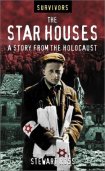 The Star Houses: A Story from the Holocaust By Stewart Ross |
Bandi Guttmann is a fourteen-year-old Hungarian Jew living in Budapest in 1944. German forces have occupied the city, and life for Bandi and his family is about to become unbearable. Set apart from the rest of the community and denied basic rights, the Guttmann family's only weapon is their determination to survive. But in the face of mindless Nazi hatred, will their strength, love, and courage be enough to hold them together? Survivors is a brand-new and dramatic collection of short novels for young readers, each book about a young person caught up in a real-life conflict or disaster that boys and girls will recognize from their history books. The stories are fiction, but through each young hero's eyes, the boys and girls who read these tales will gain a deeper understanding of the day-to-day hardships and dangers encountered by people living and surviving through troubled times. Each book has a brief introduction relating actual historical events, and at the end of each book, young readers will find a brief historical note that places the story in a larger context plus a glossary of terms specific to the time and place. Boys and girls will also find a list of suggested further reading. Line illustrations capture the atmosphere of each story.
|